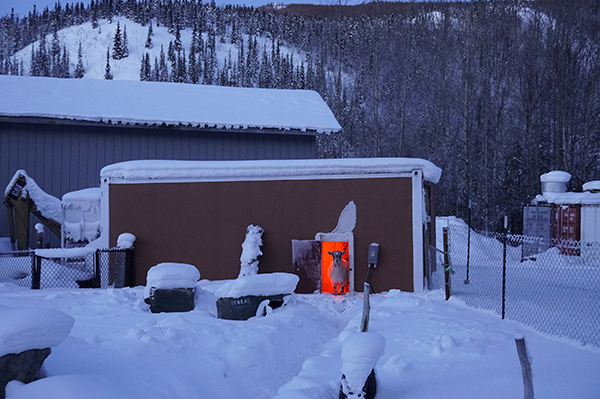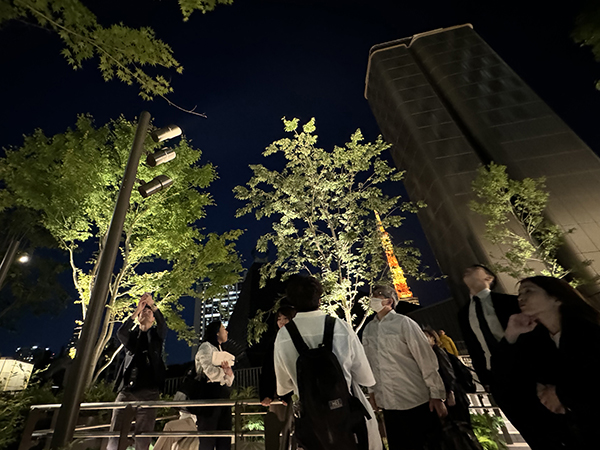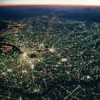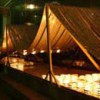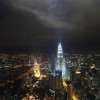Date of Issue: 28 June, 2024
-Activity 1 / City Night Survey – Alaska(2024.02.06-02.12)
-Activity 2/ Night Walk Vol. 73 – Azabudai Hills & Toranomon Hills (2024.05.10)
-Activity 3/ Round Table Discussion Vol.71– Azabudai Hills & Toranomon Hills Review (2024.05.30)
City Night Survey – Alaska
2024.02.06-02.12 Masafumi Yamamoto + Yuki Ito
We visited Alaska at the beginning of February. The purpose was to investigate the light environment in the Arctic under the theme of ‘Mother Nature’, focusing on urban areas, living environments, Eskimo life, and the wilderness. In this study, we stayed in Anchorage, the largest city in Alaska, and Fairbanks, a city
surrounded by nature. In Fairbanks, we stayed at a lodge in the mountains and observed the northern lights.

■Arctic City
After noon in Fairbanks, a city as close to the Arctic Circle as you can reach. The weather is clear. The sun has risen close to the horizon and is about to set. Houses and trees cast long shadows on the ground. It is a beautiful scene, as if I had dipped the tip of my paintbrush in dark blue watercolor paint and carefully traced a stroke on a white canvas covered with snow. The temperature here is minus 20°C (68°F). Still, I can feel the warmth of the sun on my skin. The temperature can reach minus 40°C (-40°F) during the harshest season, while the four seasons are rich in variety. The temperature drops even further when the wind blows. This is the kind of Alaska I wanted to visit. The flora and fauna live in such a harsh natural environment. Human life right next to them. We would like to investigate the lighting culture while unraveling the reasons for this.

Time is just after noon
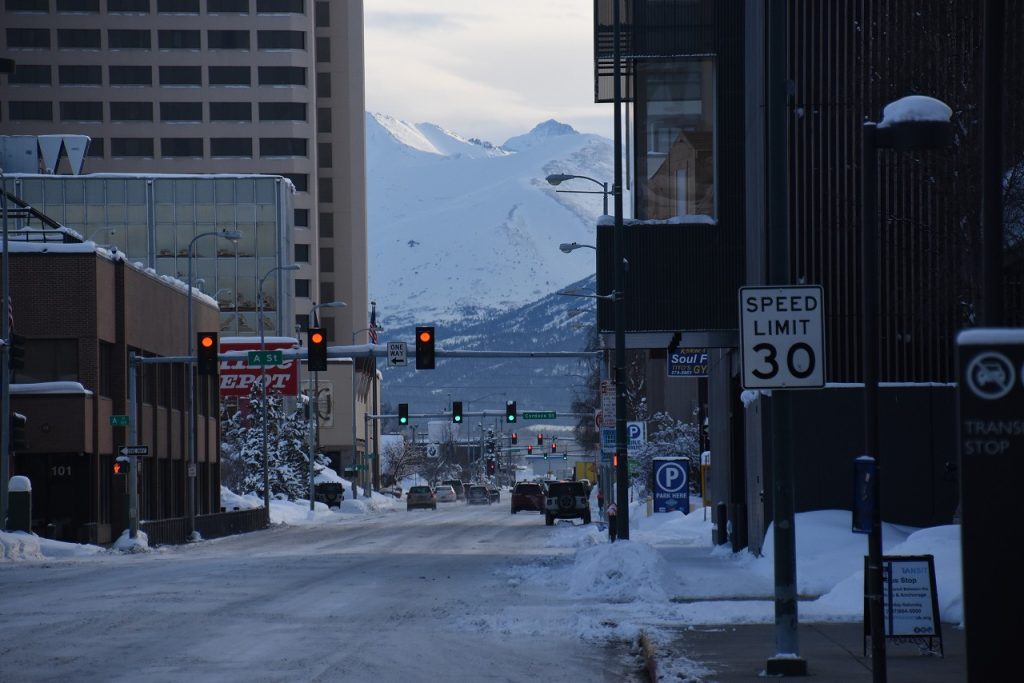
Downtown Main Street
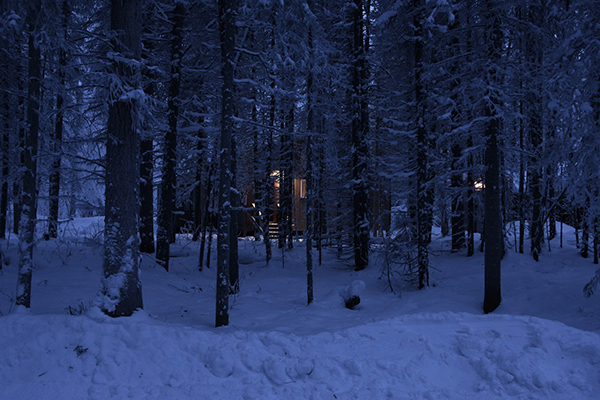
The light of a dwelling
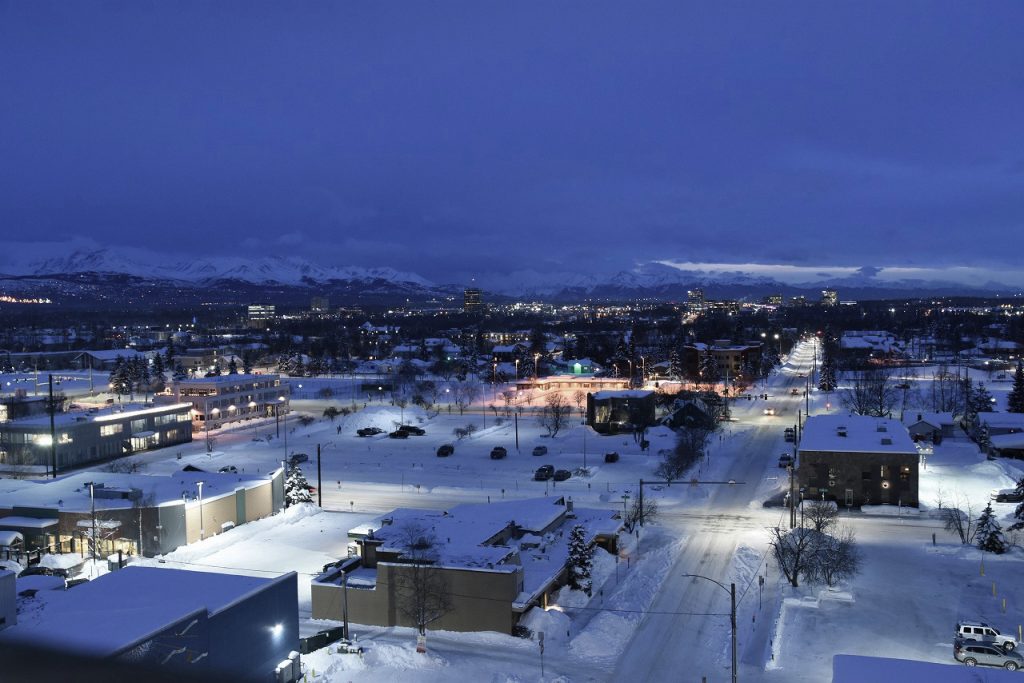

■Closing in on the Nature
The city stood as if it were in opposition to nature. Walking down a main street in downtown Anchorage, it felt as if the shadows have taken over. No sunlight reaches the street. The mountain range peeks out far beyond the frames of the buildings along the road. The mountain range glows white in the faint sunlight.
At dusk, standing on the roof of a multi-story parking garage overlooking the suburbs of the city. I looked toward the southeast. As the sun goes down, the lights of the city gradually come on. The hustle and bustle of the downtown area is soon replaced by the lights from windows of the houses, which continue to the foot of the mountains. The lights are shining even on the cold mountain surface. At this time, the outside temperature was below -10°C, but I felt warmth. But I felt warmth. Each light seemed to bring to mind the life of a person, and the scenery, which was so close to nature, made me feel this way.
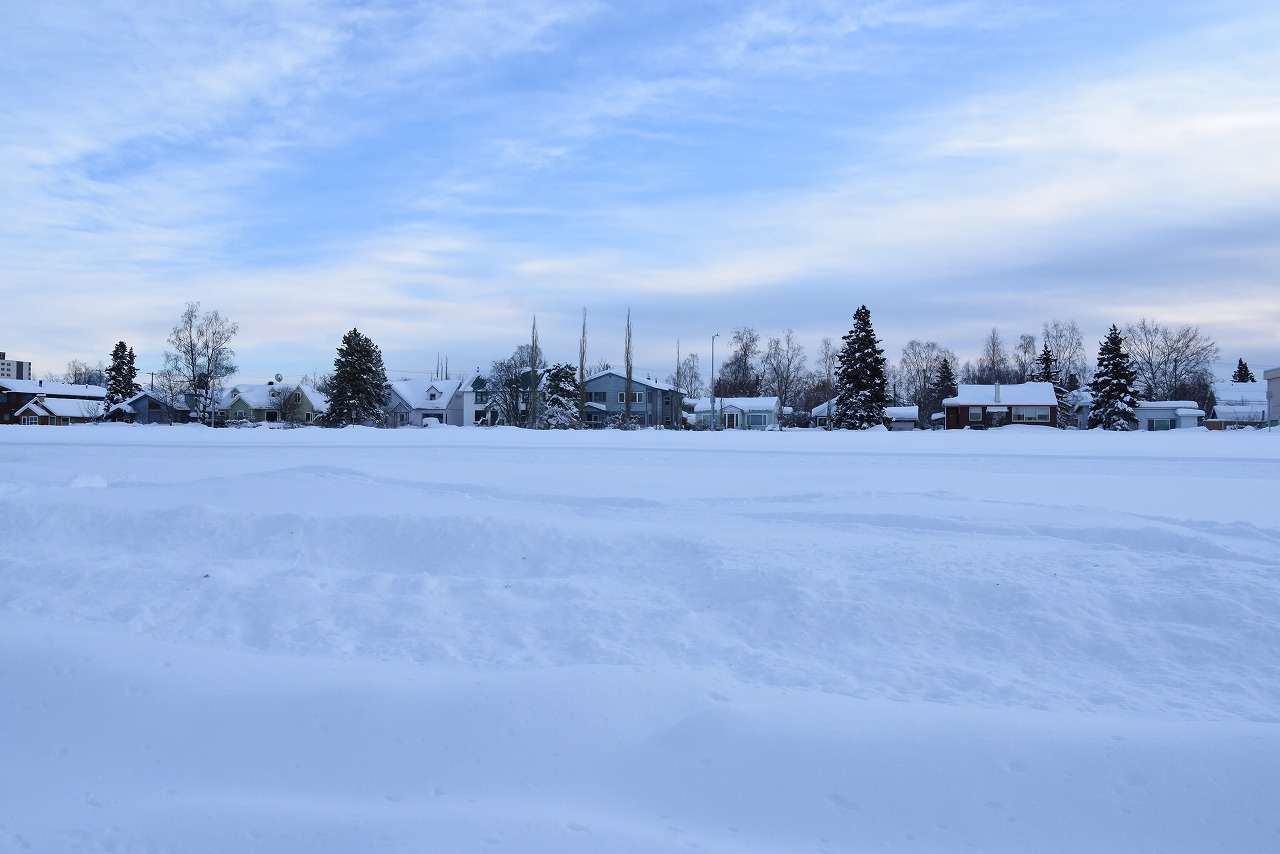
■Preparing for the survey
Preparation was necessary in order to walk in this area. Clothing should be layered to create a layer of air and easy to put on and take off, considering the temperature gap between indoors and outdoors. We wore two layers of gloves and socks, snow shoes, and a thick knit hat. A neck warmer covered up to the mouth. The essentials for the survey were a camera and an illuminometer. A spare battery was kept warm in a pocket to protect it from depletion due to the cold. When bringing the equipment from outdoors to indoors, we put it in a bag to avoid condensation and allowed it to gradually warm up to room temperature.



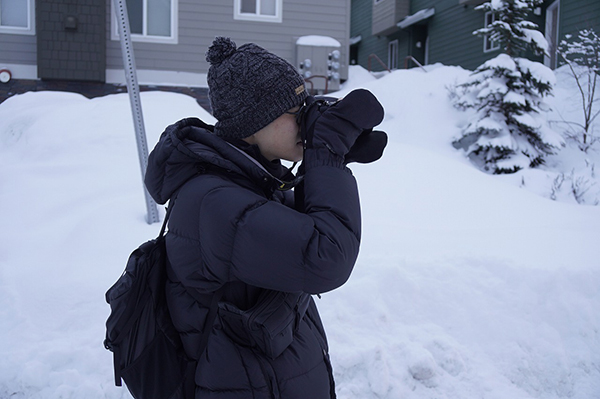
■The Spring
We greeted dusk in Fairbanks on a frozen river. Even there, our clothes protected us from the cold. As the sun sets over the river to the west, the thick, ice-covered snowfield at dusk slowly faded, as if to mirror the blue of the sky. The hustle and bustle of the city could be heard in the distance. A cold wind blew across the snowfield, gently brushing my skin. The clock struck 4:00 p.m. and the bell tolled to signal the evening. The winter solstice had passed, and in February the hours of daylight in Alaska were increasing by seven to eight minutes every day. Yes, the season was moving toward spring.
There is an event called Nenana Ice Classic in such a place. For $3, you buy a ticket, fill in a prediction of when the snow will melt on the river, put it in a red can, and then put a black-and-white pole with a flag on the end over the river. Tie the pole to the clock with a rope. When the river ice melts and the flag falls, the hands of the clock stop. Those who guess the time share the winnings. It’s a form of gambling that has been practiced here for centuries.
I felt warmth and humanity in the thoughts of the people waiting for spring. I also resonated with the richness of the people’s hearts as they set spring in motion on the frozen surface of the river. On April 27, 2024, at 5:18 a.m., the Nenana River will thaw and spring comes to Alaska.



■Life of First Nations
After spending time on the frozen river, I thought about whale fishing in the Arctic Ocean in early spring. They pitch their tents on top of the glacier and keep watch throughout the night. In the past, they spent their nights in a fire lit by seal oil. In Alaska, hunting and human life have always been closely intertwined. Hunting is an act in which humans receive benefits from nature.
For example, the stone lamps I saw at the Anchorage Museum reminded me of the depth of this history. It was used around 500-1200. They were used to fill hollows with oil and light fires to illuminate the rooms of traditional dwellings.
The oil came from animals such as whales and seals. The wicks were made of moss, sometimes mixed with cedar bark. The human figure in the center suggests nature worship. The people lit fires on nature’s bounty and used it in their daily lives. To live in this land is to live in deep connection with nature. Yes, there is a natural light there is a natural light that people living in the far north have feared, comforted, and cherished. The Northern Lights.


■The Night Sky
A single window light in the pitch blackness, the Northern Lights above it, so clear that it seems to reach the ground at any moment. It’s about a painting by Sidney Lawrence. I looked up at the downtown night sky the day I met that small oil painting at the Anchorage Museum. Of course, there was no landscape like in the painting. Streetlights illuminated the snowy, icy ground, and the city was unexpectedly bright. Cars pass by and faces of people chatting in warm restaurants float down the street. A few people pass by on the street. Young people played field hockey by the light of pole lamps in the square, panting for breath. Far from the world of paintings, the night in the Arctic city was a brief flurry of activity, and then got late.
So, in search of a quiet night sky, we headed to an observing lodge in Fairbanks. The site is surrounded by coniferous mountains. We waited in the waiting hut from a little after 9:00 p.m. until about 3:00 a.m. the next morning. It was minus 25°C outside, and just a little exposure to the open air was enough to consume one’s energy. With the University of Alaska’s Aurora Borealis forecast in hand, we went outside every few minutes to look up at the sky.
Around midnight, the northern night sky became dimly lit. The branches of the trees lining the mountain ridgelines were silhouetted against the sky. I knew then that the Northern Lights were only a trace of light. Sitting on the snow, I just look up at the sky and stare at the changing light. It is like a gentle breeze in the Arctic night sky. It is less than 0.1 lux. It is more ephemeral than moonlight or the twinkling of a star. A faint presence, so faint that it could be mistaken for a cloud, moves across the sky. When I finally came to, only the glow of the stars remained in the sky.

seen
■The Epitome of Life
During this survey, we were able to see the Northern Lights several times. One
of the most memorable experiences occurred in a taxi on the way to Fairbanks
Airport. The driver said, “You can see the Northern Lights right now.“ Looking
up from the window, I saw a faint band of pale green in the jet-black night sky over the street lights on the shoulder of the road. It was the most vivid one I saw on this trip. It was the most impressive experience because I saw the Northern Lights in the night sky of my living area. I cut out this sky in my mind and superimposed it on the Alaskan landscape I saw from the multi-level parking garage on the first day. The natural light is what makes this place special. The warmth of the lights of everyday life in the bitter cold is inspiring.
Of course, I am not talking only about lighting. My body is now suffering from intense cold. It’s also cold enough to sap one’s strength. It is the life that lives strongly in the cold that moves us. For example, when a small bird soars in the sky and perches on a tree. When you see the deep green leaves of an evergreen tree covered with snow. Or from a single road running through a vast field. Of course, the light from the windows of the houses spread out at the foot of the mountain. Or the warmth of the sun on your skin. Or the hustle and bustle of a city. Even the smallest, most ordinary things feel fresh and new in this place. People have carved out nature. And there is certainly the life of people in the magnificent nature. In this far northern region. And this scene is unfolding in the midst of severe cold weather.


■Night Flight
The captain announces that the plane has taken off from Fairbanks Airport and is flying smoothly at an altitude of 10,000 meters toward Seattle. Looking out the window, shallow green clouds were floating in the sky. We are looking at the Northern Lights at an altitude of about 100,000 meters above Canada. The chill of the city still lingers in my body. As I close my eyes, the memory of the trip fades into drowsiness. Alaska’s tremendous nature has undeniably added color to the light environment. I hope that the lights of the people’s lives, which are unique to this region, will flourish in the future, with a humanistic richness.
The seasons are turning and June is about to end. Alaska is in the white night season and there are about 19 hours of sunlight a day. The Northern Lights are no longer visible. The flowers of the rosebay will be blooming and the short summer will arrive. (Masafumi Yamamoto)

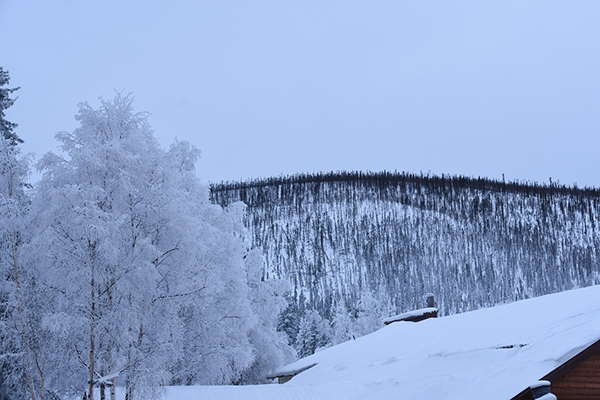
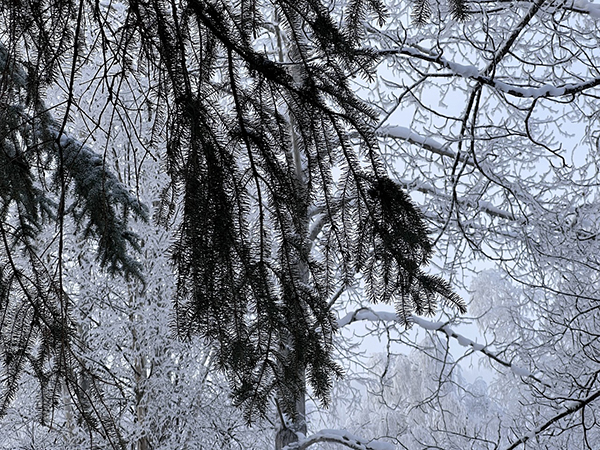
■Street Light
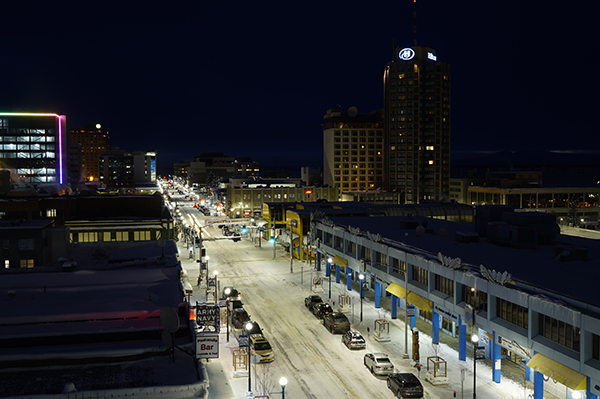
Let’s move on from the coexistence with nature to the lights of the city. Looking down on the streets of Anchorage, the entire street seems to be illuminated. I measured the illuminance and found it to be about 15 lux, which is about the brightness of a typical town. The reason why I felt the brightness was higher than the number was probably due to the fact that the entire street surface was covered with snow. Even when I left downtown and walked along the dark streets at night, the faint ambient light (e.g., window lights of houses, stars and moon) was enough to make me feel the brightness of the city. While I felt the splendor of the snowy landscape, I was also bothered by the complexity of the city lights. The color temperature of the streetlights differs from area to area, and there are decorative lights all over the city. The warm colors of the lights seemed more appropriate for the cityscape of the Arctic, which is located next to vast mountains.


■Design of pole light
Alaska has a wide variety of pole lights. There were nearly 20 different types of pole lights that we were able to identify. Some are powerfully designed, some are functional, and all seem to have been built at different times. As is often the case with cityscapes, Alaska is a mix of all eras and cultural elements due to its historical background of intervention from other countries and the resulting rapid urban development. At first I could not grasp the unique landscape of Alaska, but when I saw it as a townscape with a strong American culture, it seemed to fit.

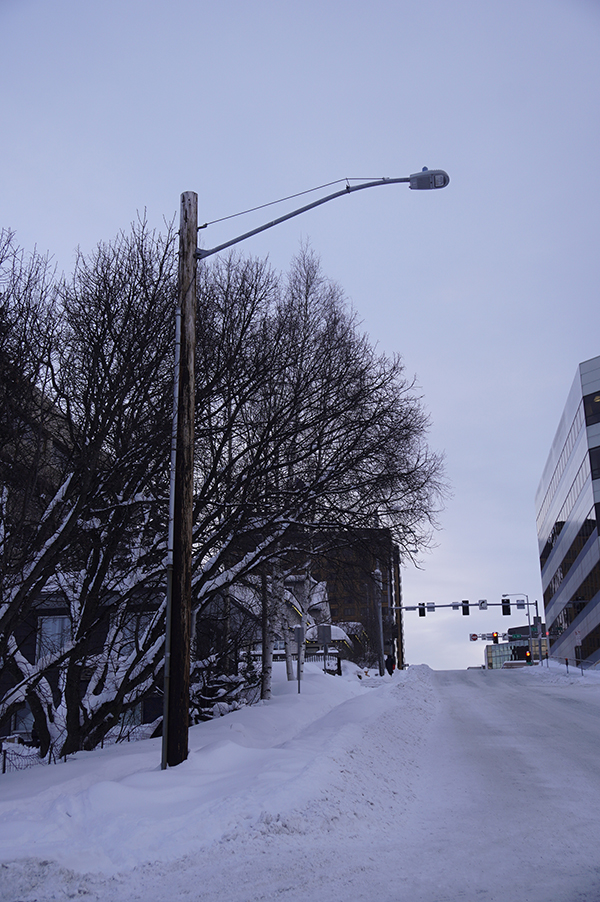

■Lights of the houses
There were few pedestrians in the city, but the residential area a short distance from the downtown area was even quieter. The only lights that stood out in the residential area were the pole lights at the intersections, and the rest were just lights leaking from the houses. Personally, I found it comfortably dark, but this darkness may have created a deeper sense of quietness. Since the area is surrounded by snow, the light leaking from the houses reflected off the snow and created sufficient brightness. The light leaking from the rooms is very gentle, slightly illuminating the snow surface.
On the other hand, there were houses that seemed to be wrapped in electric lights and some houses with excessive white light at their entrance. Overall, I got the impression that there was no sense of unity. As mentioned earlier, the ideal is to make good use of snow to create brightness in a space, but considering that snow melts in summer, it is difficult to speak only of winter scenery.


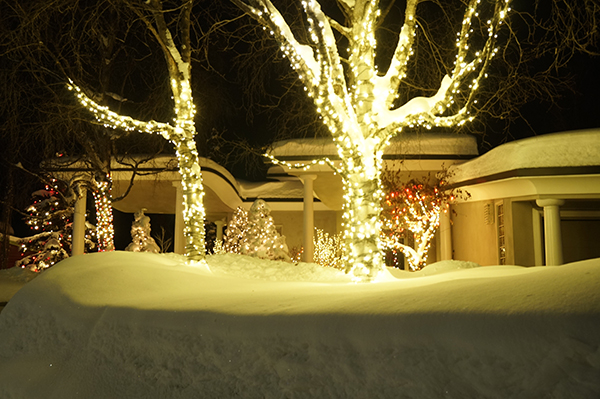
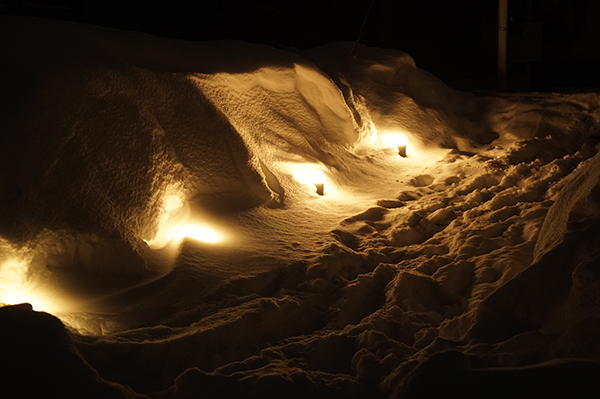

■Natural light material
The bollard lights on the approach are very impressive. Some of the bollard rides that were lower than knee level were hidden under snow, perhaps only covered over time, but the soft lighting through the snow was very beautiful.
Some of the bollards were also surrounded by snow, with the snow acting as a reflector for the bollards. We were able to catch a glimpse of how light is used in snow country, where the natural material “snow” is used as a diffusing and reflecting material.
■Chena Hot Springs
We visited Chena Hot Springs, located deep in the mountains east of Fairbanks, to observe the northern lights. Chena Hot Springs was built in the early days of Alaska’s pioneering history and became widely known around 1905 as a therapeutic hot spring for miners suffering from rheumatism. Today, many tourists visit every year to view the northern lights, making it Fairbanks’ most famous aurora interference facility. The remote hot springs of Chena are focused on renewable energy to help them survive the harsh winters.
Geothermal power generation using geothermally heated water and greenhouse vegetable gardens are just a few of the ways in which Alaska’s frigid winters demand less energy. Inside the vinyl greenhouses, the lighting was kept at 13,000 lux, a bizarre sight that one would not expect to see deep in the mountains of the far north. A few minutes’ walk from the facility, we found ourselves in a quiet forest covered with snow. I was excited to think that we might be able to see the aurora borealis at night, which would engulf this vast natural landscape.

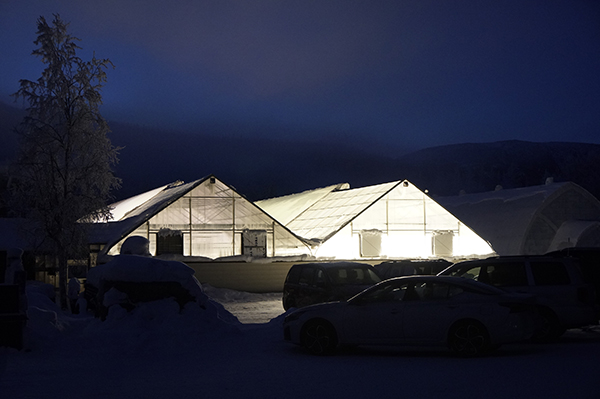
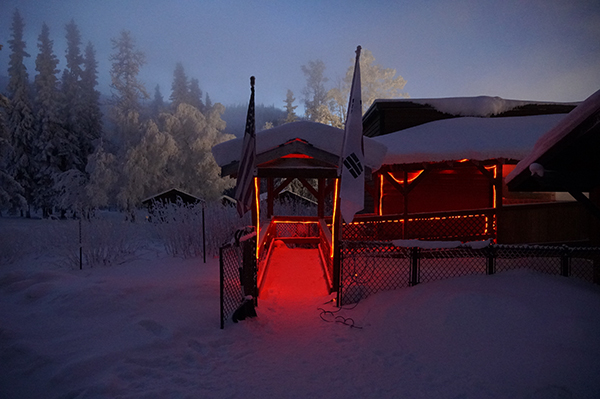
■Red light
Red lights were used throughout the Chena Hot Springs. They were also used in the passageway leading to the open-air hot springs, and several places in the city of Anchorage and Fairbanks. The use of red lighting in various places in Alaska may have been an attempt to create a sense of warmth in the harsh cold of the Alaskan climate.
One possible reason for the heavy use of lighting in the Chena Hot Springs could be consideration for nocturnal animals or its effect on auroral observation. Nocturnal animals are unable to see red light at night due to their visual function, so it has minimal effect on nocturnal animals. This may be a consideration for the many wild animals that inhabit Alaska. Incidentally, goats are not nocturnal, but the interior of the goat pen in Chena Hot Springs was dyed bright red.
Red light is also used to observe the starry sky. When red light is seen at night, it seems to be harder for the eyes to be fooled by the light than when normal light is seen, which may be very serious for aurora observation, where visibility is affected by a small amount of light.
■Lighting in the open-air bath
The main hot spring facility is an open-air bath surrounded by large rocks, although there is a simple indoor bathtub. Men and women wear swimsuits for mixed bathing, and then it is time to take a bath. I can’t even imagine being released into a world of -20°C with only a bathing suit on was too much to take in. As soon as I stepped outdoors, I thought about turning around and heading back inside. But I emptied my mind and headed to the bathtub. When I arrived, it was so dark that I could just barely recognize human face. The brightness was not created by ordinary lighting, but by the color lighting installed on the surrounding rocks. A bare light source could be seen dimly illuminated at the end of the steam. The steam diffused the light and created a fantastic atmosphere. The color lighting seemed to be an effort to evoke the aurora borealis, albeit in a subtle way.

■About the Northern Light
As mentioned above, the actual Northern Light looks very different from the photograph. While I was disappointed by the gap between the real Northern Light and the photographs, a hypothetical idea arose. In Anchorage and Fairbanks, I felt that the entire city seemed to me to be a pale landscape.
Perhaps it was the low sun, perhaps it was the buildings in the city, or perhaps it was the snow covering the entire landscape. However, for Alaska, where such pale colors prevail, I felt that the presence of the Northern Lights is a valuable element that adds vivid colors to people’s lives, even if only somewhat. The Northern Lights we saw during this survey was not the best condition. Although it’s not the best to have excessive expectations, Once I have seen the Northern Lights in their full glory drifting across the night sky, I would like to mention once again what the the Northern Lights means to Alaskans. (Yuki Ito)
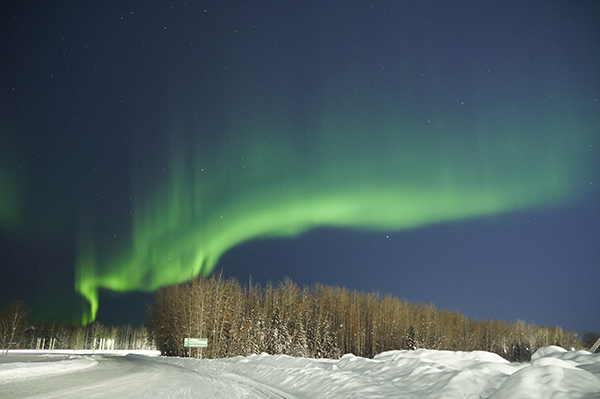
■Summary
Looking back on this survey, some of the functional landscapes in urban Alaska are indeed similar to those found in urban and snowy areas in other countries.
However, I felt that the light environment created by the lifestyle of Alaska’s people, in cohabitation with the irresistible nature, maintains a moderate balance between nature and people, and creates a nighttime landscape with a somewhat human warmth that enhances the appeal of this land. Even if urban lighting is changing in the future, I hope that this kind of warm light environment will be kept and cherished. ( Masafumi Yamamoto )
City Night Survey : Azabudai Hills~Toranomon Hills
Observe the nightscape of the newest spot, Azabudai Hills~Toranomon Hills
2024.0 5.10 Shinichi Sakaguchi + Amane Kotani+ Naoko Oguchi+ Yuko Nakayama
Eight months have passed since the last city night survey in September last year. The first city night survey in a while took place in Azabudai Hills and Toranomon Hills Station Tower, two of the hottest areas in this year. A large group of 43 people enjoyed walking around this newest spots.

A walking tour of two new hot spots in Tokyo, Azabudai Hills and Toranomon Hills Station Tower.
Due to the abundance of sights, most groups focused on Azabudai Hills, and ended up speed-walking through Toranomon Hills Station Tower as time ran out.
■ Group 1
Group1 focused on Azabudai Hills. At the entrance to the Garden Plaza, the first building in Azabudai Hills, the unanimous hero of the survey was the lighting embedded only in the automatic doors as a “modest welcome mat”. Conventionally, downlights on the ceiling surface would be used to illuminate the entrance, but integrating them with the doors keeps the doors out of the shadows and makes for a more beautiful entrance. By using this method, there is no need to worry about interference from guide lights, etc., and the floor can be well illuminated.
Once you pass through the garden plaza and step outside, the lighting in the landscape is much more subdued, and you are drawn to the lighting of the stores. What caught our attention was the entrance to the building, with its origami-like ceiling surface and lighting that naturally floated above the unevenness of the ceiling. However, once inside, the sloped ceiling with high luminous flux downlights made for a very glaring effect. We had the strong impression that the round shape of the downlights was in conflict with the intent of the wired ceiling design. In addition, lighting fixtures with different color temperatures were used, which led to a discussion as to what the intention was.
We passed through a supermarket with such an overwhelming red color scheme that it felt like the ceiling was on fire. After that, we explored the sophisticated space illuminated by curved indirect lighting and glare-less downlights. Our tour of Azabudai Hills ended there.
With little time remaining, we went through the Toranomon Hills Station Tower to investigate the building. The building has become a landmark, with symbolic images projected under the eaves of its exterior, and is visible from the surrounding area. The building was interesting to look at, with different lighting faces in the distant view (top, high-rise), mid-range view (the volume that jumped out), and near view (the digital art part), bringing out the good qualities of the architecture and the building was interesting to look at. (Amane Kotani)



■ Group 2
Group 2 walked from Azabudai Hills, past Mori JP Tower, through the central plaza to Sakuraba Dori Street. We thought the new Azabudai Hills would be full of heroes but we also found some villains, and it was a nostalgic and refreshing experience to walk the streets with a large group of people. The first thing that caught everyone’s tention was the NOA building! It was a bit surprising that many people rated the lighting of the entrance as HERO in contrast to the slightly eerie feeling outside.
Next, heroes and villains intersected at the entrance to Mori JP Tower. The lighting on the exterior wall was highly evaluated for its high illumination and uniformity maintained by indirect light from the top and spotlights from the front, but the shadows of the three-dimensional letter grew longer, making us think that indirect lighting was still difficult.
When we went to the central plaza, we found the spotlights that lit nowhere. We would have liked to ask the person who installed these lights what they were illuminating!
The most impressive feature of Sakuraba Dori Street was the lighting up of the plants! We felt that the trees were carefully lit up here. And the difference in color between the gold and silver of the Dior and Cartier was very impressive and wonderful. We could see many different faces around Azabudai Hills, but if we took more time to walk around, we might have found more things. Tokyo Tower was the most conspicuous everywhere at anytime. (Shinichi Sakaguchi)
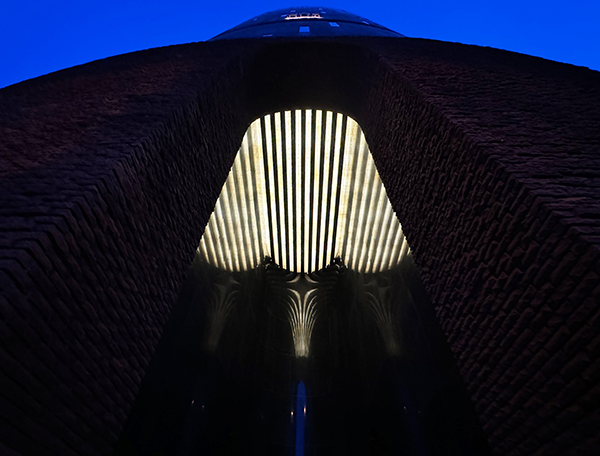
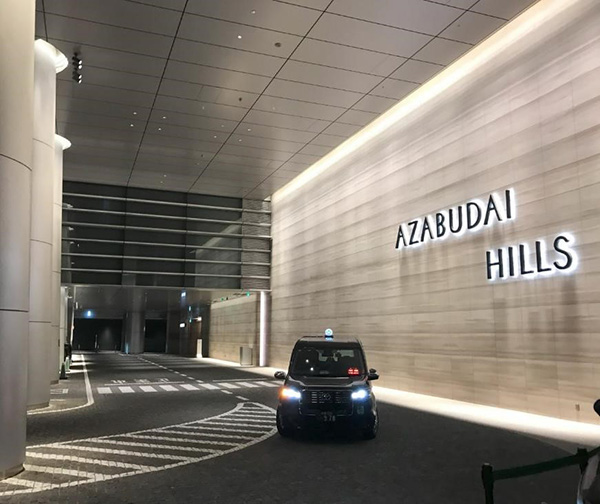

■ Group 3

The group 3 surveyed the area from Azabudai Hills to Toranomon Hills Station Tower. The high-rise JP Tower, visible from the bridge near the residence, was lit with simple vertical lines on the upper levels to emphasize its height, while the low-rise commercial facilities were softly illuminated with warm color temperatures, creating a perfect balance between the two as a hero.
In contrast, the lighting of the railing of the bridge, which serves as the viewpoint, was white and abrupt compared to the others, giving the impression that the view of Azabudai Hills was interrupted here, making it a villain.
Some said that the large roof of the central plaza of the Tower Plaza has no glare from any angle and that the unique structure of the large canopy is beautifully expressed by the lighting, while others said that the color temperature, which is set higher than that of the building, seems incongruous. The space had a strong impact, with a mixture of opinions on both sides.
The Toranomon Hills Station Tower is well received by visitors, as the ceiling at the outdoor entrance of the tower has a dynamic lighting display that guides the viewer upward, giving them a sense of the scale of the Station Tower. Some commented that the light in the ceiling slit of the atrium, which is the first thing one sees when entering the building, gives a futuristic impression by reflecting and shimmering the dynamic geometric ceiling, while others said that although it is for dramatic effect, the light emitted from the side could be too bright depending on the angle of view. The Toranomon Hills area is a very popular area. The Toranomon Hills area is characterized by vertically-expanding, linear forms and plans with sharp, urban lighting, while Azabudai Hills has a horizontally-expanding, flowing plan, with lights that are not showy and with careful attention to the color temperature of the residences, giving the entire area a gentle impression. It was a very interesting experience for me to be able to investigate the contrasting plans of the two cities at the same time. (Naoko Oguchi)


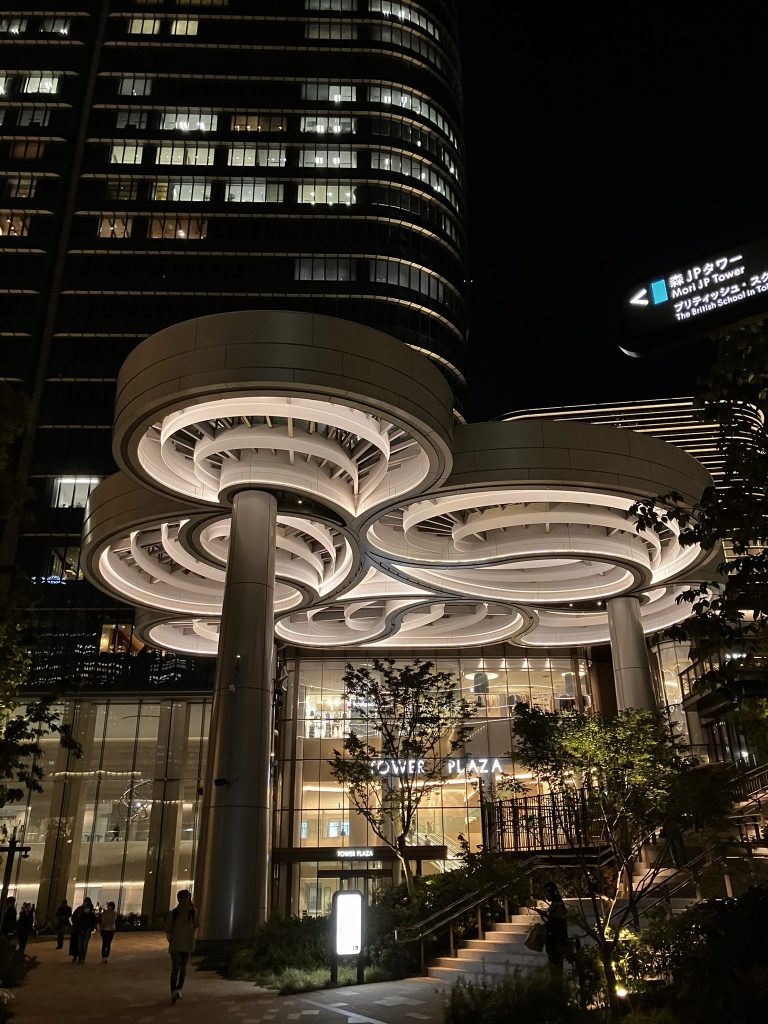
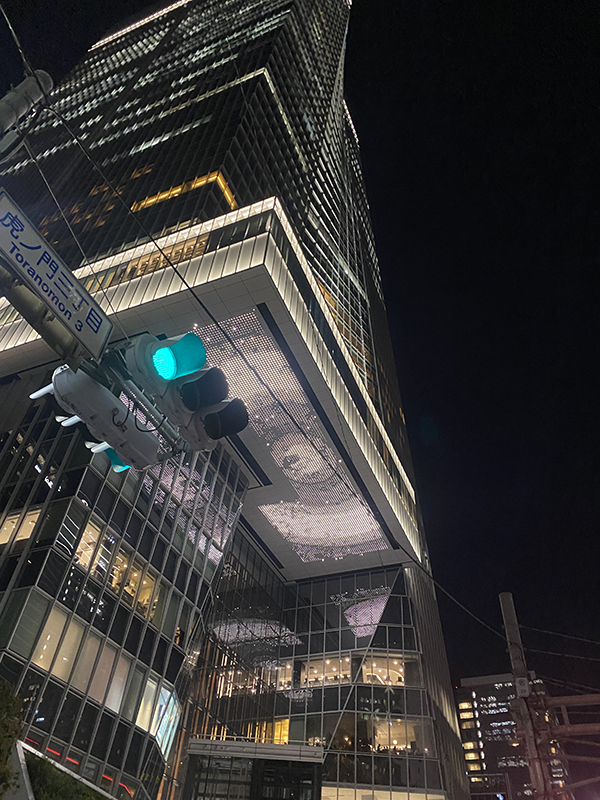
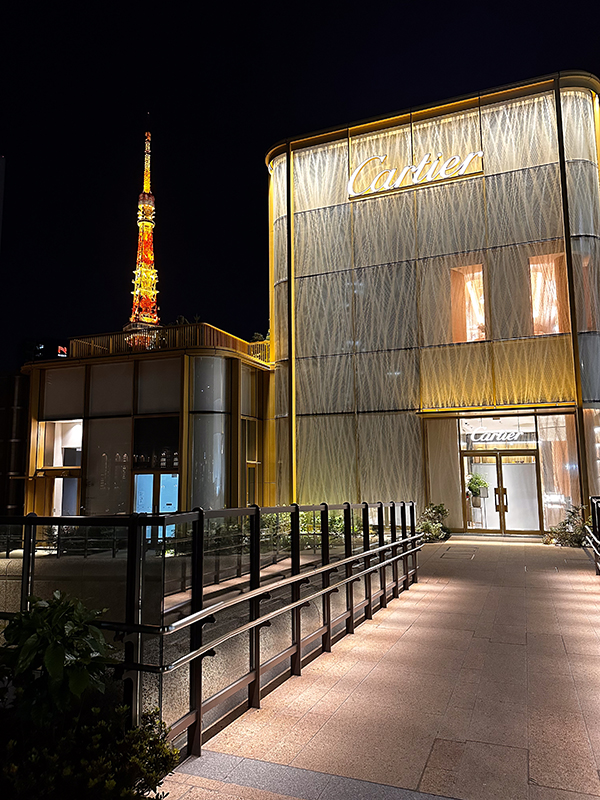
■Group 4
Group 4 left Kamiyacho Station for Azabudai Hills via Zojoji Temple. The view of Zojoji Temple, Tokyo Tower, and skyscrapers from the front side of Zojoji Temple’s main hall was particularly noteworthy. It truly symbolized the chaos that is typical of Tokyo. We were able to notice this Tokyo-like atmosphere because of the lights of the buildings from different periods floating on the dark night canvass, and it seemed to be a part of our daily life that we missed during the busy daytime. The team members commented that the light of Tokyo Tower stood out even more because Zojoji Temple was not lit up, and that the light of Tokyo Tower illuminated Zojoji Temple like a sunset. The team members again realized that Tokyo’s urban nightscape is created by the coexistence of buildings from different periods and for different purposes, and by their complementing each other.
We then arrived at Azabudai Hills and, while admiring the state-of-the-art lighting scheme, we were again impressed by the light of the Tokyo Tower. In Azabudai Hills at night, luxury brand stores shone brightly. The gold color of the Cartier store and the light bulb color of the Tokyo Tower were especially eye-catching, harmonizing with each other.
Moreover, looking up at the JP Tower from a close distance, which we could only see from a distance at Zojoji Temple, we were struck by the beauty of the indirect lighting that illuminated the slits in the façade. The gradation of light woven by the window lights made me feel the life of the city and the vibrancy of people’s lives.
Tokyo’s urban nightscape is like a huge work of art, and we are a part of it. During this city walk, we were able to confirm that the light of Tokyo Tower has a presence as a symbol of the city and that it beautifully decorates the surrounding buildings and cityscape. The views of Zojoji Temple and Azabudai Hills gave us an opportunity to learn about the diversity and vibrancy of Tokyo’s cityscape and the depth of its history. (Yuko Nakayama)

skyscrapers
I was a little nervous about whether the participants, nearly half of whom were on their first city walk, would enjoy the event, but I was relieved to see that there was a lively exchange of opinions and discussion during the walk. The nightwalk got off to a good start as the participants seemed to enjoy themselves at the gettogether after the walk. The next event will be held in Musashi-Kosugi in the summer. Please join us! (Noriko Higashi)
Round Table Discussion Vol.71: Review of Azabudai Hills & Toranomon Hills City Night Survey
2024.05.30 Noriko Higasih

A review of the May 10 City Night Survey was held. 20 people gathered at LPA on Friday night to discuss the lighting in the newest spot, Azabudai Hills.
We did the review of the May 10 Azabudai Hills & Toranomon Hills Station Tower City Night Survey. The leaders of the groups summarized their opinions and made presentations using photos of the heroes and villain of each group. The report from each group seemed to have more heroes than the past town walks.
I would like to report some common points and notable contents from each group’s presentation
■Media ceiling behind the eaves of Toranomon Hills Station Tower
Most of the teams had never seen a media ceiling before and highly evaluated it as an interesting new landmark. Some commented that the ceiling’s moving projections led visitors’ viewpoints upward, making the space appear larger. The digital lighting is very symbolic and suitable for the entrance of a new city which makes it deserve to be a hero.
■Azabudai Hills Landscape Lighting
A slightly darker lighting scheme that makes people naturally want to visit the brightly lit storefronts in the back of the building. The approach to the commercial area is less bright, making the store facade more conspicuous. The uplighting of trees, which usually tends to be a villain, was also well-lit, although there were some too dazzling spots depending on the type of tree.
Opinions about the lighting at the entrance of Heatherwick’s distinctive design varied. Some commented that the lights are illuminated at night and have a strong presence and are very good, or, the swirls of white light are so uplifting that one feels like being sucked in when looking for the light source, and that there is no glare from any angle and the unique structure of the large canopy is wonderfully expressed. On the other hand, some commented that the color temperature was set too high, unlike the color temperature inside the building, which may have been the intention, but it seemed incongruous.
In addition to the above, various heroes, villain, and insights were shared, including the successes and failures of new lighting challenges in the building, bad examples of sign lighting, and empathy for areas that seem to be struggling. Some of these details are too detailed or confidential to be left in the newsletter, so please come to the salon to hear them in person. You can attend it online either. So if you have never attended one before, please feel free to do so. We’ll be happy to see you there! (Noriko Higashi)








